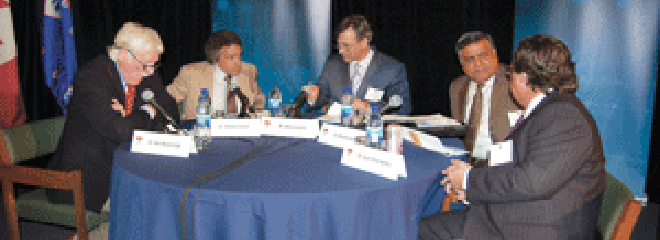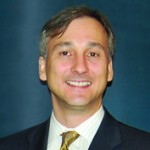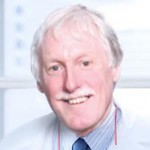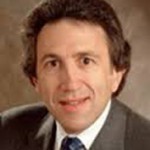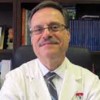By Bernard Lord, John Keyserlingk, Mohamed Nanji, Sheldon Elman, Jean Tchervenkov
Private health care delivery exists in Canada but the relationship between public and private contrasts in important ways with that in other countries. Four Canadian physicians who have ventured into private delivery describe their activities and their interactions with the public sector. —Report from a presentation at the 2009 conference of the MUHC-ISAI
Same day breast cancer diagnosis
Dr. John Keyserlingk is a surgical oncologist at the MUHC and Medical Director of the Ville Marie Medical and Women’s Health Centre, which he founded in 1994 to provide quick access to gold standard technology for the diagnosis of breast cancer. It was the first Canadian site to introduce Digital Mammography, 3D4D ultrasound, minimally invasive vacuum-based biopsies and same-day pathology results. It now has 60 staff members and 20 oncologists.
Dr. Keyserlingk started the company after efforts to have better technology introduced into the public system failed. “We were told that if we wanted expensive new technology we would have to pay for it ourselves,” he said. Today, the Centre straddles public and private realms, charging patients for services not available in the public system, such as same-day diagnosis, electronic charting and multidisciplinary follow-up, but performing all surgeries within the public system. Dr. Keyserlingk is committed to a very transparent mix of private and public care, and seamless transition between the two.
The Centre’s relationship with the public system has, however, been confrontational. “Every time we bring in new technology, we face a legal battle with government,” stated Dr. Keyserlingk. “We thought the Centre might challenge the public system to adopt better technology and care models, but it has not worked that way.” Rather, the public sector in Québec adopts a defensive stance and tries to prevent those services being offered anywhere. “The biggest step forward would be to come clean that there are some things the public sector cannot afford, and welcome other ways to provide those services.”
The physicians at the Centre continue to work in the public system as well, but according to Dr. Keyserlingk, “Government applies a lot of pressure to make them choose between the two.” Bureaucracy aside, however, “patients have decided that we offer a worthwhile supplement to public health care.”
Horizontal integration with the public sector
Dr. Mohamed Nanji is an anesthetist and founding partner and current President and CEO of the 20-year-old Surgical Centres Inc. (SCI), which operates private ambulatory surgical centres in Alberta and BC. The principals of the company are anesthetists and they work with surgeons from different specialties. Rather than vertical models where a centre takes one particular procedure from start to finish, SCI is horizontally integrated with the public system. For example, SCI’s New Westminster clinic has a contract to do fine wire needle biopsies of the breast for the Vancouver Regional Health Authority. Patients come across the street from the hospital to the clinic to have the biopsy done and SCI pathologists send results back to the hospital on the same day. “In this way, we can work with the public sector to provide expedited diagnosis,” said Dr. Nanji.
SCI has been able to adapt to changing relationships with the public sector. When it opened in 1988, SCI was a totally private centre where patients paid the facility fees and doctors billed the health care plan. In 1995, the federal government rapped Alberta’s knuckles for allowing facility fees, so government assumed the facility fees. “That was the start of our private-public partnership,” said Dr. Nanji. Despite the press around it, Alberta’s Bill 11 actually created a very restrictive environment in which to run a private facility. “The only way you can provide private health services in Alberta today is by working for the Workers’ Compensation Board or contracting with Alberta Health Services,” stated Dr. Nanji. Government pays private centres on a per procedure basis for equipment and staff, while the physicians bill the health care plan.
“Surgeons come to work with us because the environment is comfortable, patient satisfaction is extremely high, and efficiency and throughput are high, which is important to physicians who are paid on a case basis,” Dr. Nanji maintains. “Patients are never bumped for emergencies. Surgeon input into service design is welcome. We offer consistent staff and state of the art equipment.” SCI assumes a teaching function in all its clinics, with agreements with the different Colleges to provide training to nurses, LPNs and residents.
Preventive health care
Dr. Sheldon Elman is a family physician and CEO of Medisys, a private company he started in Montreal in 1981 to offer preventive executive health services. It has since grown to a publicly traded company with 35 offices across Canada, 20 free-standing imaging centres and 700 employees. “Our growth is the result of the empowerment of informed consumers over the past decade to a point where they are now deciding who is going to take care of them and how,” said Dr. Elman.
In Canadian provinces today, decisions about the care provided are not based on the physician’s choice but rather on who is paying for the particular service. For example, physicians in Ontario get paid for ultrasound services provided in their offices, while physicians in Quebec do not.
“In 1976,” recounted Dr. Elman, “I opened my family practice and bought an electrocardiogram (ECG) machine, which cost $3000. At that time we were getting enough from the Régie d’assurance maladie de Québec (RAMQ) per ECG that it made sense. Today, the fee has dropped to $1 per ECG and physicians no longer buy the machines, preferring to send the patient to a hospital where it costs $100. This decision-making process does not meet patient needs and does not save money.”
In 1981 there was very little emphasis on prevention, and people who wanted help to take care of themselves had nowhere to turn. Last year Medisys saw over 16,000 executives. “There is such an incessant demand for treatment in the public system that wellness does not get emphasized,” explains Dr. Elman. “Physicians who come to work with us appreciate having the time to discuss wellness and preventive measures with the patient.”
Access to specialists
Dr. Jean Tchervenkov is Director of Live Donor Kidney Transplantation Services at the Royal Victoria Hospital, Director of Pediatric Transplantation at The Montreal Children’s Hospital and President of MD Specialists in Montreal. The MD Specialists clinic facilitates collaborative team work and allows patients to be treated more promptly. Specialists at the clinic work with referring doctors from the public and private systems and with a group of private radiologists in an adjacent office. “Since our private clinic opened a radiology facility, it has been easier for the hospital to retain and recruit radiologists,” asserts Dr. Tchervenkov.
“A number of physicians are underutilized in the public system and surgeons certainly do not get the operating room time they need,” maintained Dr. Tchervenkov. “We are teachers and researchers, and find ways to keep busy, but the demand from patients is still there. As well, we see a constant loss of some of our most talented surgeons to other jurisdictions in North America that are better equipped to employ their skills.”



